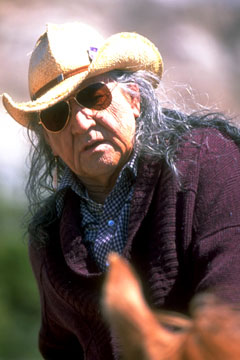Indians supposed to be Lakota
Pine Ridge 90210Pine Ridge is the Native 90210. Movies, from the smallest independent film to large productions hoping to capture the Native experience, find their inner and outer Indianness here. Dreamkeeper. Rez Bomb. Thunderheart. Skins. Dances with Wolves. Imprint. The Stone Child. Crazy Horse or historical movies with Pine Ridge themes filmed elsewhere like Bury My Heart at Wounded Knee and Into the West.
On any July afternoon, tow-headed tourists from Germany, Austria and the Netherlands can be found sipping a cold soda at Big Bats or breathlessly snapping pictures at the local pow wow. They love Indians; especially these Indians. Because Pine Ridge, above all others, represents what INDIANS ARE SUPPOSED TO BE. It must be so because they’ve seen it in the movies.


4 comments:
Ahhh...but we know the reason.It's all those handsome, semi-clothed "braves" with their long black hair blowing in the wind-LOL!!! (Smiley-face-icon-with-a-wink-moment).
Gets 'em into the theatre every time!
Living here on Navajo land in Kayenta, Arizona (one of the Gateways to Monument Valley) we deal with so many of these curious tourist seeking the "Hollywood Indian". As some of you may know, Monument Valley has been used in many films, many depicting Natives Hollywood style. These tourist unfortunately are ignorant, they have been spoon-fed the typical Hollywood image of Natives. If you ever get a chance, talk to these people. Yes, they may ask some really dumb-ass questions, but what you have to realize is that these people have been continuiously fed this Hollywood Indian B.S. for decades. A little education on our part really does go a long way. I have a number of funny stories about tourist ignorance towards Natives. I was hitch hiking on highway 163 a number of years back, a car with 3 German tourist picked me up. They asked me if I was an "Indian". I said yes I was. They thought I was kidding because I wasn't wearing feathers in my hair and wasn't riding a horse. One even said he had been looking out the car window for hours looking for a brightly feathered Indian riding a horse hiding somewhere in the distance. I am totally serious, this guy was actually looking out the window of the car with a camera in one hand and binoculars in the other as he was telling me this. After telling these people that we the Navajo actually lived in houses, not tee pees, and that we drove cars and trucks, and rode horses for enjoyment, rodeo, and work, they had a very very hard time to take it seriously. Sometimes you have to shake your head at these kind of people, but this is the way they see Natives because of Hollywood. Now I can understand this kind of ignorance coming from a European, but ignorance like that from people in North America is simply unacceptable and just plain F'd up.
"[T]his is the way they see Natives because of Hollywood." Exactly, Shonie, except writerfella thinks people learn stereotypes from their parents, churches, and the community, not from Hollywood. Apparently his experiences are different from those of every other Native who's addressed the question.
I think we can count Dreamkeeper and Into the West as made-for-TV movies that were presented as series. If a production has movie-like qualities, it doesn't matter whether a network shows it in one block or splits it into episodes.
Shonie's position is clear: "[T]his is the way they see Natives because of Hollywood." If you disagree, quit pussyfooting around and say so. Yes or no: Do people see Natives the way they do because of Hollywood? I say yes and so does everyone else except you.
I've acknowledged the role of schools in introducing stereotypes. But you haven't acknowledged the role of the media in introducing them. Here are the quotes in case anyone's interested:
writerfella:
"Racist and stereotypical ideas are learned at home and in the communities gated or otherwise and in schools and even in church. What happens to such ideas is that they can be reinforced but not ordinarily introduced originally by books, movies, and/or TV."
Rob:
"You really think most people sit around the dinner table or the church pews discussing Indians? And parents instruct their kids on the finer points of playing cowboys and Indians? I must've had an unusual upbringing, because that wasn't my experience. I doubt my family mentioned Indians even once. I haven't polled the people I know, but I'm guessing none of them discussed Indians either.
"School is a different matter. But how many hours of instruction do you think schoolchildren get about Indians? Forty? Eighty? Whatever the number, I bet most kids spend more hours playing games, watching Western movies and TV shows, reading books and comic books, dressing up for Halloween, coloring in coloring books, watching football games with mascots, etc."
"I'm talking many more hours. In fact, I bet it isn't even close. It's tough to quantify, but I'd guess my media exposure to Indians outweighed my scholastic exposure by at least 2 to 1. More likely the ratio was 4 to 1, 8 to 1, or more."
writerfella:
"'Culture' is taught at home, 'culture' is taught in the communities gated or otherwise, 'culture' is taught in schools, and 'culture' is taught in church."
Rob:
"Children may learn about mainstream American culture in their homes and schools, but they generally learn about ethnic cultures (other than their own) in schools and the media. With the emphasis on the latter."
Readers can determine for themselves whether I've characterized your views correctly. I'd say I have.
Post a Comment